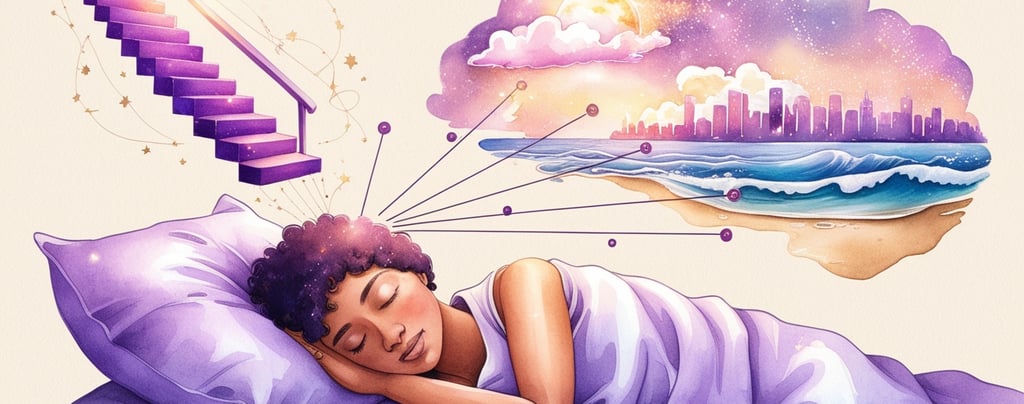Change Nightmares: Explore Dreams Alteration
Discover the science behind dreams and the possibilities of rewriting dream stories. Explore the risks and benefits of living in custom dream worlds and altering nightmares in real time.
Black Heart
4/19/20254 min read


What If We Could Alter Dreams in Real Time?
Introduction
Dreams are weird, aren’t they? One night, you’re flying over cities like a superhero, the next you’re being chased by a giant talking toaster. But what if you didn’t have to just watch your dreams like a random movie? What if you could step in, hit pause, rewrite the script, and change everything while it’s happening?
This isn’t just late-night speculation. Neuroscientists, sleep researchers, and even tech startups are starting to wonder the same thing. So let’s explore the fascinating question: what if we could alter dreams in real time?
How Dreams Work (and Why They’re So Hard to Control)
Dreams mostly happen in REM sleep, when your brain is highly active, almost like you’re awake. In this stage:
The brain mixes memories, emotions, and imagination.
Logic takes a backseat.
The prefrontal cortex (decision-making hub) is less active.
That’s why dreams feel chaotic. You don’t decide what happens. Instead, your brain cooks up strange stories using raw materials from your waking life.
This chaos is exactly why the idea of real-time editing feels so powerful.
Lucid Dreaming: The First Step
If you’ve ever realized mid-dream, “Wait… I’m dreaming,” congratulations, you’ve had a lucid dream. Lucid dreamers can:
Fly, teleport, or shape-shift.
Change dream settings.
Even talk to dream characters knowingly.
But here’s the catch: lucid dreaming takes practice, and most people can’t do it on command. It’s like trying to hack into your own brain without a manual.


Real-Time Dream Alteration: The Tech Possibility
Scientists are experimenting with ways to influence dreams:
Targeted Memory Reactivation (TMR): Playing certain sounds during sleep can guide dream content. For example, hearing guitar chords might trigger a dream of playing music.
Electrical brain stimulation: Small zaps to certain brain regions can boost lucid dreaming frequency.
Wearables and headbands: Devices track sleep cycles and try to “nudge” you into lucidity by flashing lights or sounds.
Now imagine combining these with brain-computer interfaces (BCIs). You could have a dashboard, almost like a VR controller, for your dreams.
What If Nightmares Could Be Fixed Instantly?
One of the most exciting uses would be treating nightmares.
Soldiers with PTSD could rewrite traumatic dreams into safe, healing ones.
Kids haunted by monsters could swap them for superheroes.
Anxiety dreams (like teeth falling out) could be neutralized before they spiral.
This could transform sleep therapy, mental health, and even trauma recovery.
Could Dreams Become Our Personal VR Worlds?
Think about it: dreams are already immersive, limitless, and hyper-real. If we could alter them, they’d become the ultimate VR playground.
Want to practice a speech? Run it in a dream.
Want to experience space travel? Alter the dream.
Want to meet your younger self or long-lost loved one? Rewrite the scene.
It could blur the line between gaming, therapy, and daily life.
The Creepy Side: Who Controls the Script?
Here’s where it gets unsettling.
What if corporations inserted ads into dreams? (“Buy this soda in your dream!”)
What if hackers injected fears or false memories into your dream?
What if governments used it for propaganda or mind control?
Since dreams feel real, dream-editing could become the most powerful psychological tool ever.


Would Dream-Altering Change Reality Itself?
If we could rewrite dreams every night, would it change how we live when we’re awake?
Memory blending: Dream edits might leak into real memories, confusing fact and fiction.
Emotional regulation: You could wake up happier, calmer, or more creative after customizing dreams.
Escapism: Some people might prefer their dream world over reality, like being addicted to a virtual universe.
Key Points Breakdown
Dreams are chaotic because logic shuts down in REM sleep.
Lucid dreaming already allows some editing, but it’s rare.
Scientists are exploring sound cues, brain stimulation, and wearables to influence dreams.
Real-time dream editing could heal nightmares and PTSD.
Dreams could become personalized VR experiences.
But dangers include ads, hacking, and propaganda.
Dream editing might blur reality and imagination.
FAQs
Q: Is real-time dream editing possible today?
Not fully. Lucid dreaming and sleep tech let us influence dreams, but direct editing is still experimental.
Q: Could this help mental health?
Yes. Nightmare therapy, anxiety treatment, and emotional healing are some of the most promising uses.
Q: Could it be dangerous?
Potentially. If abused, dream-editing could manipulate memories, emotions, and even beliefs.
My Thoughts
Personally, I find this idea both thrilling and terrifying. Thrilling because it could help so many people, imagine rewriting trauma into healing. Terrifying because dreams are the last private space we have. If corporations or governments ever gained access, our subconscious would no longer be safe.
So while I’d love to fly on command in my dreams, I’d also want strict protections. Because once we can edit dreams, the line between sleeping and waking reality may never be the same again.
🔗 Related Articles from EdgyThoughts.com
🌐 External Resource
Read more about the science of dreams on Wikipedia: Dream.